CHARLES W. MORGAN
THE LAST WOODEN WHALESHIP IN THE WORLD
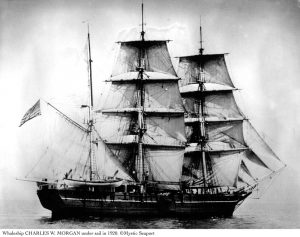 The Charles W. Morgan is the last of an American whaling fleet that numbered more than 2,700 vessels. Built and launched in 1841, the Morgan is now America’s oldest commercial ship still afloat – only the USS Constitution is older.
The Charles W. Morgan is the last of an American whaling fleet that numbered more than 2,700 vessels. Built and launched in 1841, the Morgan is now America’s oldest commercial ship still afloat – only the USS Constitution is older.
The Morgan was launched on July 21, 1841, from the yard of Jethro and Zachariah Hillman in New Bedford, Massachusetts. It typically sailed with a crew of about 35, representing sailors from around the world. The whaleship measures 106 feet, 11 inches length on deck with a beam measuring 27 feet, 9 inches. Its main truck on the mainmast is 110 feet above the deck; fully-rigged, and the ship carries 7,134 square feet of sail. The huge try-pots used for converting blubber into whale oil are on deck; below are the cramped quarters in which the officers and men lived.
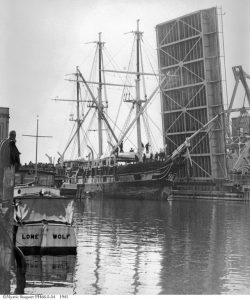
Over an 80-year whaling career, the Morgan embarked on 37 voyages with most lasting three years or more. Built for durability, not speed, it roamed every corner of the globe in pursuit of whales. The Morgan is known as a “lucky ship,” having successfully navigated crushing Arctic ice, countless storms, Cape Horn roundings and, after finishing its whaling career, even the Hurricane of 1938.
After its whaling days ended in 1921, the Morgan was preserved by Whaling Enshrined, Inc. and exhibited at Edward H.R. Green’s estate at Round Hill in South Dartmouth, Massachusetts, until 1941. In November of that year, the Morgan came to Mystic Seaport Museum where it has since dominated the waterfront at Chubb’s Wharf.
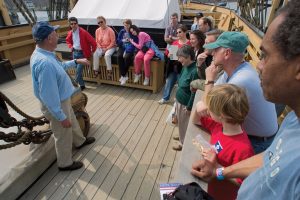 The whaleship was designated a National Historic Landmark by order of the Secretary of the Interior in 1966, and is also a recipient of the coveted World Ship Trust Award. Since its arrival at Mystic Seaport Museum, more than 20 million visitors have walked its deck. Where once it hunted and processed whales for profit, its purpose now is to tell an important part of our nation’s maritime heritage and the lessons that history has for current generations.
The whaleship was designated a National Historic Landmark by order of the Secretary of the Interior in 1966, and is also a recipient of the coveted World Ship Trust Award. Since its arrival at Mystic Seaport Museum, more than 20 million visitors have walked its deck. Where once it hunted and processed whales for profit, its purpose now is to tell an important part of our nation’s maritime heritage and the lessons that history has for current generations.
RESTORATION, PRESERVATION AND THE 38TH VOYAGE
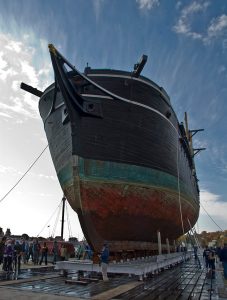
At Mystic Seaport Museum, the Charles W. Morgan has been given a new lease on life; however, its future vitality depends on continual preservation. A major program of restoration and preservation was begun in 1968 to repair it structurally, and during the course of this work, it was decided to restore the ship to the rig of a double-topsail bark, which it carried from 1867 through the end of its whaling career. the ship appears as it was during most of its active career.
In January 1974, after removal from a sand and mud berth, the ship was hauled out on the lift dock in the Henry B. duPont Preservation Shipyard for inspection and hull work as needed. The hull proved to be in remarkably good condition, with only a new false keel, worm shoe and some planking being required.
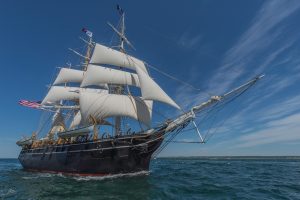
In November 2008, the Morgan returned to the Museum’s shipyard for another restoration. The project renewed areas of the vessel from the waterline down to the keel and also addressed issues in the bow and stern. The whaleship was re-launched July 21, 2013 and left Mystic Seaport Museum May 17, 2014, to embark on a 38th Voyage to historic ports of New England. The nearly three-month journey raised awareness of America’s maritime heritage and called attention to issues of ocean sustainability and conservation. The ship returned from its voyage August 6, 2014, and resumed its role as an exhibit and the flagship of the Museum.
THE 38TH VOYAGE
History was made during the summer of 2014 when Mystic Seaport Museum took the last remaining wooden whaleship in the world back to sea. Following a five-year restoration, the Charles W. Morgan sailed on her 38th Voyage to New England ports-of-call, raising awareness of America’s maritime heritage and calling attention to issues of ocean sustainability and conservation.


